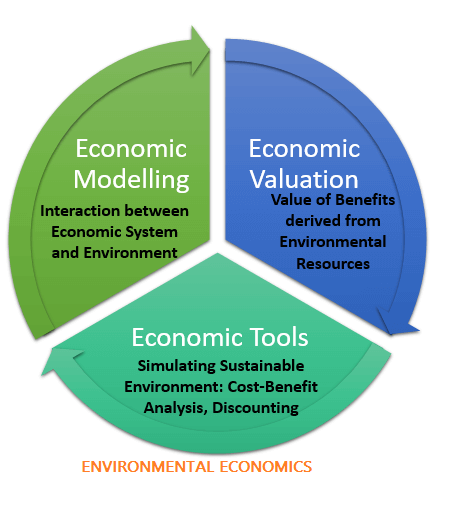Environmental Economics
What is Environmental Economics
Environmental Economics is the extension of the branch of economics that deals with the economic issues of environment, measurement of pollution and policy prescriptions. Basically, environment has four important or major roles. These are:
1. Life-support function of environment:
Heal (2007) has stated that environment helps us to live a healthy life. For example, we can say that environment produces various things (viz. oxygen) those help us to live our life healthily.
2. Sink-function of ecology:
We use the environment as a sink. Waste materials are often dumped into the environment. As an example, it can be said that we put our domestic wastage to the municipal cars (in India) and they use to dump it in a fixed place. Other than domestic sources, there are other sources too, viz. agriculture and industries from where waste materials are generated (Kolstad, 2000). They also use the environment as their sink.
3. Source-function of ecology:
The environment is very often used as source function. There are lots of practical examples of it. We can say that various plants are used to produce medicines (Sankar, 2001).
4. Amenity-values of ecological resources:
The environment has its own aesthetic beauty that is enjoyable to each and every human-being. After a tiresome session of work, we choose to spend a vacation out of either the town or the state or the country (Sandmo, 2015). Forest, oceans, mountains have their own amenity values, whether is it substitutable or not is subject to the taste of individuals.
Each and every point bears two common implications. The first one is that it has some benefits and the second one is that there is a certain cost assigned to it. Hence, it is the subject of cost-benefit analysis. Hence, typical economic tools cannot be applied here to describe this as it is (Mäler & Vincent, 2003). Thus, by using standard economic tools as weapons we need to tackle this cost-benefit analysis as there as separate functions associated with it.

Importance of Environmental Economics
Environmental economics has a vast and revolutionary history as a subject. Going beyond neo-classical economics, development economics as well as growth economics, we need to study this part of economics tenderly. Neo-classical economics is the sole base of it (Kolstad, 2000). Growth economics deals with capital accumulation, rather physical capital accumulation and investing in human capital as the prior importance and development economics deals with its efficiency, equity, and sustainability. As per Heal (2007), Pareto-optimality is that state where one cannot be better off without reducing the benefit of other. But, environmental economics deals with a different sphere of the Economics literature. Recycling policy, climate change policy, nuclear power, and traffic congestion charging are the main issues which are discussed on the ground of economic thoughts in this section (Sandmo, 2015). Therefore, the economic policies and activities, affecting the environment, are the main concern to study this wing of Economics.
Environmental economics is the combination of two different studies – environmental science and the economic interaction of human in the market. Therefore, we need to study Environmental Economics to capture the following dimensions of environmental and economic activities – environmental valuation, air pollution, natural resources, land degradation, climate change, sustainable development, international common goods, natural reserves, water pollution, and waste management. These studies conclude that the basis of this wing of mainstream Economics is a market failure and evaluation of environmental programs. Many people also use the name ecological economics to describe the interactions of environment with economic systems of consumption and production. Ecological economics also deals with designing policies of economic growth such that it strengthens ecological health rather than destroy it.

Major Questions for Environmental Economics
Environmental Economics and Market Failure
Market failure can be defined as the inefficient allocation of the resources in the market or more precisely, in the free market. The market failure uses to occur due to the mismatch between the quantity supplied and the quantity demanded (Davis & Reilly, 2010). Therefore, market failure is the economic condition where the market is not in the equilibrium condition. Therefore, the competitive market is the only ideal market where the market failure cannot take place. Without this type of market form, all the classical market forms, starting from Monopoly to Oligopoly, market failure is possible. There may be various reasons for market failure (Ahn, Kweon, Tak & Park, 2012). These reasons are going to be discussed in the next section of the analysis.
Types of market failures
Externality
The externality is defined by Xinga (2011), as the outcome of the economic activity of a person, experienced by a third party consumer who is not related to that particular economic activity. The externalities can be of two types – positive externalities and the negative externalities (Allcott, Mullainathan & Taubinsky, 2012). If the production or consumption of a particular commodity has a positive effect or benefit to the third party consumer or producer, it is called the positive externalities. On another hand, the negative impact of consumption or production activities on a third party is known as the negative externalities (Davies, 2013). Therefore, the externalities can be possible of both kinds of economic activities – production and consumption.
Public goods
According to Kotsogiannis & Serfes(2010), the public good is often provided by the government or few non-government organizations for the consumption of the society without any charges applied. The two basic features of a public good are – non-excludability and non-rivalry. The most common examples of public goods are – roads, street lights, public defenses, etc. (Johnson, 2015). The main problem related to a public good is the free rider problem. This problem implies that any person can enjoy the benefit of a public good without paying for the consumption. Therefore, the consumption of public good to one person is possible without reducing the availability of the good for another person in the society.
Imperfect information
Another important reason for the market failure is the imperfect information or asymmetric information regarding a commodity in the market. According to Xinga (2011), the ‘market for lemons’ is the root cause of the existence of asymmetric information. A common example of imperfect information is the market for used cars. The sellers of used cars often provide inadequate information about the product to the customers. They often hide the loopholes and negative sides of their product and highlight the well-functioning parts of the product so that their used product can be sold at a highest possible price.
Tragedy of commons
Another important issue related to Environmental Economics is Tragedy of commons. In some situations, it is impossible to exclude the potential consumers from a common-pool resource and the cost of the exclusion is very high in this case. As a result, the flow of benefits is limited to a finite level (Ohler & Billger, 2014). Therefore, the rational consumers exhausted the resources for the common purpose of utility maximization. The most common example of the tragedy of commons is fishing (Abbott & Wilen, 2011). The fishing is the fishermen's interest in earning more income. More and more fishing provides more and more income and the fisherman is benefited more and more. As a result, this practice increases more and more with other fishermen and the main resource of earning (fish) is exhausted eventually. The worst consequence of this practice is the suffering of the global population.
Evaluation Process for Environmental Programs
The sustainability of the environmental condition needs high-quality environmental programs to achieve the success in the continuously changing behavior of the environment (Kolstad, 2000). The environmental program management organizations, arranging the environmental programs, use to strive for better techniques for the evaluation. The outcome-based evaluation process is rapidly growing as a common practice of the evaluation process (Heal, 2007). Several environmental economists have provided different views in their different logical models with illustrative examples about the evaluation processes of environmental programs.
Get in touch with our Economics Tutors online to learn more about Techniques of Environmental Economics such as Cost-Benefit Analysis, Present Value Calculations, Time Value of Money, Externalities, pricing of public goods as well as topics in Game Theory and Strategic Decision making.
Important topics in Environmental Economics
Books and References for further Assignment of Environmental Economics and Ecological Economics
Abbott, J., & Wilen, J. (2011). Dissecting the tragedy: A spatial model of behavior in the commons. Journal Of Environmental Economics And Management, 62(3), 386-401. http://dx.doi.org/10.1016/j.jeem.2011.07.001
Ahn, S., Kweon, Y., Tak, W., & Park, S. (2012). PROSPECTIVE VALIDATION OF ADJUSTED BLOOD REQUIREMENT INDEX FOR PREDICTING TREATMENT FAILURE OF ACUTE VARICEAL BLEEDING. Journal Of Hepatology, 56, S261. http://dx.doi.org/10.1016/s0168-8278(12)60671-0
Allcott, H., Mullainathan, S., & Taubinsky, D. (2012). Externalities, internalities, and the targeting of energy policy. Cambridge, Mass.: National Bureau of Economic Research.
Davies, W. (2013). When Is a Market Not a Market?: 'Exemption', 'Externality' and 'Exception' in the Case of European State Aid Rules. Theory, Culture & Society, 30(2), 32-59. http://dx.doi.org/10.1177/0263276412456567
Davis, P., & Reilly, A. (2010). Market power, market outcomes, and remedies in the UK groceries market. Agricultural Economics, 41, 93-108. http://dx.doi.org/10.1111/j.1574-0862.2010.00492.x
Heal, G. (2007). A Celebration of Environmental and Resource Economics. Review Of Environmental Economics And Policy, 1(1), 7-25. http://dx.doi.org/10.1093/reep/rem001
Johnson, M. (2015). Public Goods, Market Failure, and Voluntary Exchange. History Of Political Economy, 47(Suppl 1), 174-198. http://dx.doi.org/10.1215/00182702-3130499
Kolstad, C. (2000). Environmental economics. New York: Oxford University Press.
KOTSOGIANNIS, C., & SERFES, K. (2010). Public Goods and Tax Competition in a Two-Sided Market. Journal Of Public Economic Theory, 12(2), 281-321. http://dx.doi.org/10.1111/j.1467-9779.2009.01439.x
MaÌler, K., & Vincent, J. (2003). Handbook of environmental economics. Amsterdam: Elsevier.
Ohler, A., & Billger, S. (2014). Does environmental concern change the tragedy of the commons? Factors affecting energy saving behaviors and electricity usage. Ecological Economics, 107, 1-12. http://dx.doi.org/10.1016/j.ecolecon.2014.07.031
Sandmo, A. (2015). The Early History of Environmental Economics. Review Of Environmental Economics And Policy, 9(1), 43-63. http://dx.doi.org/10.1093/reep/reu018
Sankar, U. (2001). Environmental economics. New Delhi: Oxford University Press.
Xinga, M. (2011). Network Externality and R&D Decisions in a Monopoly Market Existing Uncertainty. Energy Procedia, 13, 9947-9953. http://dx.doi.org/10.1016/j.egypro.2011.12.823


